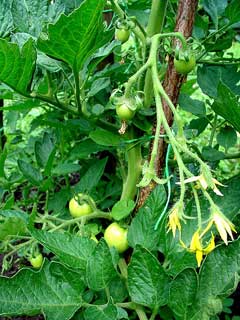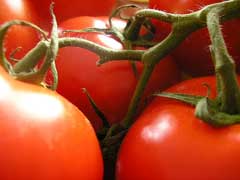 |
|
|
 |
| http://www.flickr.com/photos/aileron/2478360/sizes/z/in/photostream/ |
Translate this page:
Summary
Physical Characteristics

 Lycopersicon esculentum is a ANNUAL growing to 2 m (6ft) by 0.4 m (1ft 4in).
Lycopersicon esculentum is a ANNUAL growing to 2 m (6ft) by 0.4 m (1ft 4in).
See above for USDA hardiness. It is hardy to UK zone 9 and is frost tender. It is in flower from June to September, and the seeds ripen from August to October. The species is hermaphrodite (has both male and female organs) and is pollinated by Insects. The plant is self-fertile.
Suitable for: light (sandy), medium (loamy) and heavy (clay) soils and prefers well-drained soil. Suitable pH: mildly acid, neutral and basic (mildly alkaline) soils. It cannot grow in the shade. It prefers moist soil.
UK Hardiness Map
US Hardiness Map
Synonyms
L. lycopersicum.
Plant Habitats
Cultivated Beds;
Edible Uses
Edible Parts: Fruit Oil
Edible Uses: Oil
Fruit - raw or cooked[1, 2, 3, 37]. It can be used as a savoury vegetable or flavouring in cooked foods, or can be eaten out of hand as a dessert fruit. It is much used in salads and as a flavouring in soups and other cooked foods[183]. A juice made from the fruit is often sold in health food shops[183]. The fruit can also be dried and ground into a powder that can be used as a flavouring and thickening agent in soups, breads, pancakes etc[183]. An edible oil is obtained from the seed[46, 61, 171]. Suitable for culinary purposes[183]. The seed is small and it would be very fiddly to utilize. It is only viable to use the seed as a source of oil if large quantities of the plants are being grown for their fruits and the seed is not wanted.
References More on Edible Uses
Medicinal Uses
Plants For A Future can not take any responsibility for any adverse effects from the use of plants. Always seek advice from a professional before using a plant medicinally.
Antirheumatic Cardiac Homeopathy Odontalgic Skin
The pulped fruit is an extremely beneficial skin-wash for people with oily skin. Sliced fruits are a quick and easy first aid treatment for burns, scalds and sunburn[201]. A decoction of the root is ingested in the treatment of a toothache[218]. The skin of tomato fruits is a good source of lycopene, a substance that has been shown to protect people from heart attacks. It seems to be more effective when it is cooked and so can be obtained from food products such as tomato ketchup and tinned tomatoes[246]. Lycopene has also been shown to have a very beneficial effect upon the prostate and is being used increasingly to treat enlarged prostate and the difficulties in urination that accompany this disorder. A homoeopathic remedy is made from the plant[7]. It is used in the treatment of rheumatism and severe headaches[7].
References More on Medicinal Uses
The Bookshop: Edible Plant Books
Our Latest books on Perennial Plants For Food Forests and Permaculture Gardens in paperback or digital formats.

Edible Tropical Plants
Food Forest Plants for Hotter Conditions: 250+ Plants For Tropical Food Forests & Permaculture Gardens.
More

Edible Temperate Plants
Plants for Your Food Forest: 500 Plants for Temperate Food Forests & Permaculture Gardens.
More

More Books
PFAF have eight books available in paperback and digital formats. Browse the shop for more information.
Shop Now
Other Uses
Cosmetic Insecticide Oil Repellent
The strong aroma of this plant is said to repel insects from nearby plants[7, 18, 20]. A semi-drying oil is obtained from the seed. It can be used in making soap[46, 61, 171]. See the notes above regarding utilization. A spray made from tomato leaves is an effective but very poisonous insecticide[201]. It is especially effective against ants[7] but should be used with great caution because it will also kill beneficial insects and, if ingested, is toxic to humans[K]. The pulp of the fruit is used cosmetically in face-packs[7].
Special Uses
References More on Other Uses
Cultivation details
Requires a rich well-drained soil in a warm sunny position. The tomato is widely grown throughout the world for its edible fruit. There are many named varieties and over the considerable period of cultivation by humans two distinct types have emerged[183]. These are:- L. esculentum cerasiforme (Dunal.)A.Gray. This is the cherry tomato. Closer to the original species, it produces a large crop of small fruits with a delicious sweetness. L. esculentum esculentum. This is the more commonly grown tomato with much larger fruits. There are a very large number of cultivars with a wide variety of colours and fruit shapes and sizes. Tomato plants are not frost-tolerant and generally, need to be started off in a greenhouse in the spring if they are to succeed outdoors in Britain. They also need a hot sunny summer if they are to fruit well. Some varieties have been developed that can be successfully grown outdoors during the summer in temperate climates such as Britain, although good summers are still required in order to get reasonable yields. Varieties have been developed in Eastern Europe that can flower and set fruit at 7°c (this is compared with a temperature requirement of 11 - 13°c in earlier varieties). These varieties could provide a basis for the commercial outdoor cultivation of tomatoes in Britain[141]. Tomatoes grow well with asparagus, parsley, brassicas and stinging nettles[18, 54]. They are also a good companion for gooseberries, helping to keep them free of insect pests[201]. They dislike growing near fennel, kohl-rabi, potatoes[18, 20] and brassicas[20] (this is not a typing error, merely a difference of opinion between different books). This species hybridizes with L. pimpinellifolium (which is called L. esculentum pimpinellifolium by some botanists) but it does not hybridize with L. peruvianum[114].
References Carbon Farming Information and Carbon Sequestration Information
Temperature Converter
Type a value in the Celsius field to convert the value to Fahrenheit:
Fahrenheit:
The PFAF Bookshop
Plants For A Future have a number of books available in paperback and digital form. Book titles include Edible Plants, Edible Perennials, Edible Trees,Edible Shrubs, Woodland Gardening, and Temperate Food Forest Plants. Our new book is Food Forest Plants For Hotter Conditions (Tropical and Sub-Tropical).
Shop Now
Plant Propagation
Seed - sow early spring in a warm greenhouse. Germination is usually quick and good. Pot up the seedlings into individual pots of fairly rich compost as soon as the first true leaf appears and plant them out after the last expected frosts. Seed can also be sown in situ under a cloche at the end of April, though in a cool summer the results may be disappointing. The seedcoat may carry tomato mosaic virus. However, by sowing the seed 15mm deep the seedcoat will remain below the soil surface when the seed germinates and the disease will be inactivated[124].
Other Names
If available other names are mentioned here
Native Range
Coming Soon
Weed Potential
Right plant wrong place. We are currently updating this section.
Please note that a plant may be invasive in one area but may not in your area so it's worth checking.
Conservation Status
IUCN Red List of Threatened Plants Status :

Growth: S = slow M = medium F = fast. Soil: L = light (sandy) M = medium H = heavy (clay). pH: A = acid N = neutral B = basic (alkaline). Shade: F = full shade S = semi-shade N = no shade. Moisture: D = dry M = Moist We = wet Wa = water.
Now available:
Food Forest Plants for Mediterranean Conditions
350+ Perennial Plants For Mediterranean and Drier Food Forests and Permaculture Gardens.
[Paperback and eBook]
This is the third in Plants For A Future's series of plant guides for food forests tailored to
specific climate zones. Following volumes on temperate and tropical ecosystems, this book focuses
on species suited to Mediterranean conditions—regions with hot, dry summers and cool, wet winters,
often facing the added challenge of climate change.
Read More
Expert comment
Author
Mill.
Botanical References
200
Links / References
For a list of references used on this page please go here
Readers comment